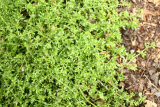Additional notes (click to expand)
Horticulture
A slow growing, matt-forming, groundcovering annual or perennial with a tap-root. The shoots are numerous, prostrate, 5-30cm long, green, slightly hairy but glabrous, much-branched. The leaves are up to 1cm long (usually much shorter), ovate-lanceolate, acute, sometimes ciliate. The flowers are tiny, 1.8-2.2mm in diameter, regular, green and arranged in dense axillary clusters. Fruit is a nutlet, glossy, at first reddish then black, 5-6mm long, not opening. This plant is a British native, growing to 3cm high by 30cm wide.
Launert, Edmund. (1981). Edible and Medicinal Plants of Britain and Northern Europe. The Hamlyn Publishing Group Ltd. p.42
Grows well in hot dry soils. Dislikes excessive moisture. The leaves emit a musky smell when they are handled.
Grow in fertile, humus-rich, well-drained soil in full sun. This plant can grow as groundcover or as an undershrub, in nutritionally poor soil and can tolerate some drought and strong winds.
Sow seed at 13- 18°C in early spring, or in-situ in late spring. Pest and disease trouble free.
Plants for a Future (2015) at www.plantsforafuture.org.uk http://www.pfaf.org/user/Plant.aspx?LatinName=Herniaria+glabra
link
Medicinal
In traditional medicine the whole plant is astringent, very actively diuretic and expectorant. It appears to have an antispasmodic effect upon the bladder and is used in the treatment of dropsy, catarrh of the bladder, cystitis and kidney stones. It has also gained a reputation for treating hernias. Externally, it has been used as a poultice to speed the healing of ulcers.
https://pfaf.org https://pfaf.org/User/Plant.aspx?LatinName=Herniaria+glabra
Nomenclature
It is also called Smooth Rupture wort. The species name glabra means 'smooth' or 'hairless' referring to the leaves.
It was formerly used to treat hernias as well as cuts - herniated skin. In this capacity, it received its common name, Rupture wort.
Other use
An aqueous extract of the plant is a hand cleanser, making the skin soft and supple.
Plants for a Future (2015) at www.plantsforafuture.org.uk http://www.pfaf.org/user/Plant.aspx?LatinName=Herniaria+glabra
link
According to Mrs Grieve, Rupter Wort has very active diuretic properties, which have been found successful in the treatment of dropsy, whether of cardiac or nephritic origin. Folk medicine recommends it as a depurative.
Grieve, Mrs M. (1931). A Modern Herbal, Penguin. Leyel, Mrs CF p.697
Phytochemistry
Active ingredients: saponin, the glycoside herniarin, essential oil, tannins.
Launert, Edmund. (1981). Edible and Medicinal Plants of Britain and Northern Europe. The Hamlyn Publishing Group Ltd. p.42
Geographical distribution
- Africa, Northern Africa, Algeria
- Africa, Northern Africa, Egypt
- Africa, Northern Africa, Libya
- Africa, Northern Africa, Morocco
- Africa, Northern Africa, Tunisia
- Asia-Temperate, Caucasus, Transcaucasus
- Asia-Temperate, Middle Asia, Kazakhstan
- Asia-Temperate, Middle Asia, Kyrgyzstan
- Asia-Temperate, Middle Asia, Tadzhikistan
- Asia-Temperate, Middle Asia, Uzbekistan
- Asia-Temperate, Siberia
- Asia-Temperate, Western Asia, Afghanistan
- Asia-Temperate, Western Asia, Iran
- Asia-Temperate, Western Asia, Lebanon-Syria
- Europe, Eastern Europe, Baltic States
- Europe, Eastern Europe, Belarus
- Europe, Eastern Europe, East European Russia
- Europe, Eastern Europe, Ukraine
- Europe, Middle Europe, Austria
- Europe, Middle Europe, Belgium
- Europe, Middle Europe, Czech Republic
- Europe, Middle Europe, Germany
- Europe, Middle Europe, Hungary
- Europe, Middle Europe, Netherlands
- Europe, Middle Europe, Poland
- Europe, Middle Europe, Switzerland
- Europe, Northern Europe, Denmark
- Europe, Northern Europe, Great Britain
- Europe, Northern Europe, Sweden
- Europe, Southeastern Europe, Albania
- Europe, Southeastern Europe, Greece
- Europe, Southeastern Europe, Italy
- Europe, Southeastern Europe, Romania
- Europe, Southeastern Europe, Yugoslavia
- Europe, Southwestern Europe, France
- Europe, Southwestern Europe, Portugal
- Europe, Southwestern Europe, Spain
Herniaria glabra L.
Family: CARYOPHYLLACEAEGenus: Herniaria
Species: glabra L.
Common names: Rupture Wort; Herniary Breastwort; Smooth Rupturewort
Distribution summary: Africa, Europe, temperate Asia
Conservation status (IUCN Red List): Not Evaluated
Habit: Perennial
Hardiness: H5 - Hardy; cold winter
Habitat: Disturbed ground, roadsides, dry, sandy soil
Garden status: Currently grown
Garden location: Classical Europe & Middle East (M)
Flowering months: June, July, August
Reason for growing: Medicinal
